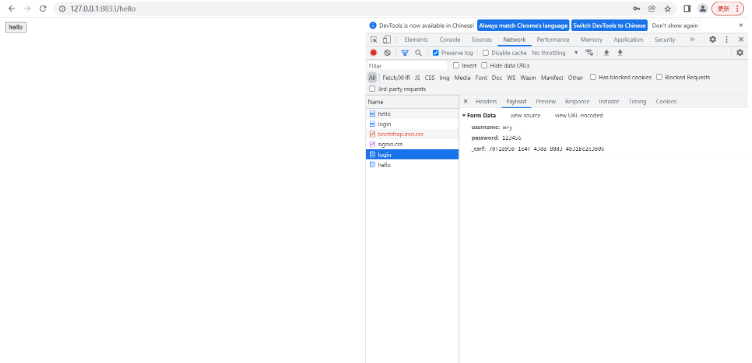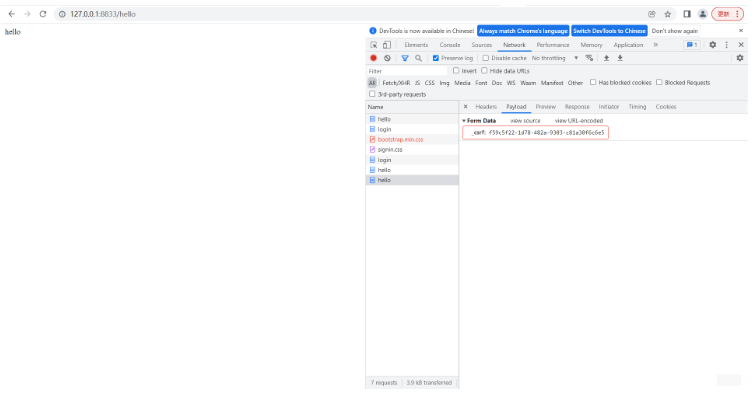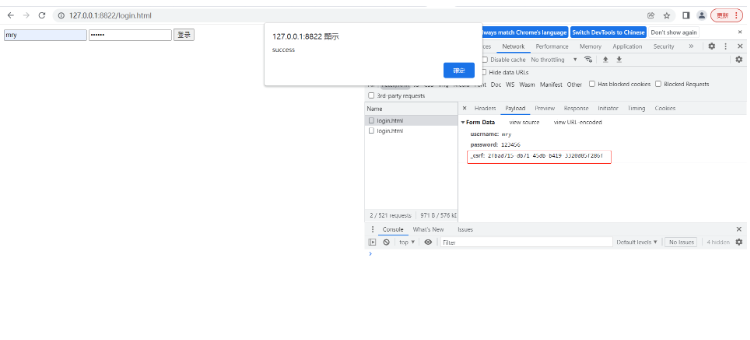这篇文章主要介绍“SpringBoot防御CSRF攻击的流程及原理是什么”的相关知识,小编通过实际案例向大家展示操作过程,操作方法简单快捷,实用性强,希望这篇“SpringBoot防御CSRF攻击的流程及原理是什么”文章能帮助大家解决问题。
想要防御 CSRF 攻击,那我们需要先搞清楚什么是 CSRF 攻击,通过下面图例来和大家梳理 CSRF 攻击流程:

其实这个流程很简单:
1.假设用户打开了招商网上银行网站,并且登录。
2.登录成功后,网上银行会返回Cookie给前端,浏览器将Cookie保存下来。
3.用户在没有登出网上银行的情况下,在浏览器里打开了一个新的选项卡,然后又去访问了一个危险网站。
4.这个危险网站上有一个超链接,超链接的地址指向了招商网上银行。
4.用户点击了这个链接,由于这个超链接会自动携带上浏览器中保存的Cookie,所以用户不知不觉中就访问了网上银行,进而可能给自己造成了损失。
CSRF的流程大致就是这样,接下来用一个简单的例子展示一下CSRF到底是怎么一回事。
1.我创建一个名为 csrf-mry 的 Spring Boot 项目,这个项目相当于我们上面所说的网上银行网站,创建项目时引入 Web 和 Spring Security依赖,如下:
<dependencies>
<dependency>
<groupId>org.springframework.boot</groupId>
<artifactId>spring-boot-starter-security</artifactId>
</dependency>
<dependency>
<groupId>org.springframework.boot</groupId>
<artifactId>spring-boot-starter-web</artifactId>
</dependency>
</dependencies>2.创建成功后,方便起见,我们直接将 Spring Security 用户名/密码 配置在 application.properties 文件中:
server.port= 8866
spring.security.user.name=javaboy
spring.security.user.password=1233.然后我们提供两个测试接口
package com.mry.csrf.controller;
import org.springframework.web.bind.annotation.GetMapping;
import org.springframework.web.bind.annotation.PostMapping;
import org.springframework.web.bind.annotation.RestController;
@RestController
public class CsrfDemoController {
@PostMapping("/transfer")
public void transferMoney(String name, Integer money) {
System.out.println("name = " + name);
System.out.println("money = " + money);
}
@GetMapping("/hello")
public String hello() {
return "hello";
}
}假设 /transfer 是一个转账接口(这里是假设,主要是给大家演示 CSRF 攻击,真实的转账接口比这复杂)。
4.我们还需要配置一下 Spring Security,因为 Spring Security 中默认是可以自动防御 CSRF 攻击的,所以我们要把这个关闭掉。
package com.mry.csrf.config;
import org.springframework.context.annotation.Configuration;
import org.springframework.security.config.annotation.web.builders.HttpSecurity;
import org.springframework.security.config.annotation.web.configuration.WebSecurityConfigurerAdapter;
@Configuration
public class SecurityConfig extends WebSecurityConfigurerAdapter {
@Override
protected void configure(HttpSecurity http) throws Exception {
http.authorizeRequests().anyRequest().authenticated()
.and()
.formLogin()
.and()
.csrf()
.disable();
}
}配置完成后,我们启动 csrf-simulate-web 项目。
5.我们再创建一个 csrf-loophole-web 项目,这个项目相当于是一个危险网站,为了方便,这里创建时我们只需要引入 web 依赖即可。
项目创建成功后,首先修改项目端口:
server.port= 88556.然后我们在 resources/static 目录下创建一个 hello.html ,内容如下。
<!DOCTYPE html>
<html lang="en">
<head>
<meta charset="UTF-8">
<title>Title</title>
</head>
<body>
<form action="http://localhost:8866/transfer" method="post">
<input type="hidden" value="javaboy" name="name">
<input type="hidden" value="10000" name="money">
<input type="submit" value="点击查看美女图片">
</form>
</body>
</html>这里有一个超链接,超链接的文本是点击查看美女图片,当你点击了超链接之后,会自动请求 http://localhost:8866/transfer 接口,同时隐藏域还携带了两个参数。
配置完成后,就可以启动 csrf-loophole-web 项目了。
接下来,用户首先访问 csrf-simulate-web 项目中的接口,在访问的时候需要登录,用户就执行了登录操作,访问完整后,用户并没有执行登出操作,然后用户访问 csrf-loophole-web 中的页面,看到了超链接,好奇这美女到底长啥样,一点击,结果钱就被人转走了。
先来说说防御思路。
CSRF 防御,一个核心思路就是在前端请求中,添加一个随机数。
因为在 CSRF 攻击中,黑客网站其实是不知道用户的 Cookie 具体是什么的,他是让用户自己发送请求到网上银行这个网站的,因为这个过程会自动携带上 Cookie 中的信息。
所以我们的防御思路是这样:用户在访问网上银行时,除了携带 Cookie 中的信息之外,还需要携带一个随机数,如果用户没有携带这个随机数,则网上银行网站会拒绝该请求。黑客网站诱导用户点击超链接时,会自动携带上 Cookie 中的信息,但是却不会自动携带随机数,这样就成功的避免掉 CSRF 攻击了。
Spring Security 中对此提供了很好的支持,我们一起来看下。
Spring Security 中默认实际上就提供了 csrf 防御,但是需要开发者做的事情比较多。
首先我们来创建一个新的 Spring Boot 工程,创建时引入 Spring Security、Thymeleaf 和 web 依赖。
1.pom信息
<dependencies>
<dependency>
<groupId>org.springframework.boot</groupId>
<artifactId>spring-boot-starter-web</artifactId>
</dependency>
<dependency>
<groupId>org.springframework.boot</groupId>
<artifactId>spring-boot-starter-security</artifactId>
</dependency>
<dependency>
<groupId>org.springframework.boot</groupId>
<artifactId>spring-boot-starter-thymeleaf</artifactId>
</dependency>
<dependency>
<groupId>org.springframework.boot</groupId>
<artifactId>spring-boot-starter-test</artifactId>
<scope>test</scope>
</dependency>
</dependencies>2.项目创建成功后,我们还是在 application.properties 中配置用户名/密码
spring.security.user.name=mry
spring.security.user.password=1234563.接下来,我们提供一个测试接口
package com.mry.csrf.controller;
import org.springframework.web.bind.annotation.PostMapping;
import org.springframework.web.bind.annotation.ResponseBody;
import org.springframework.web.bind.annotation.RestController;
@RestController
public class SecurityCsrfController {
@PostMapping("/hello")
@ResponseBody
public String hello() {
return "hello";
}
}注意,这个测试接口是一个 POST 请求,因为默认情况下,GET、HEAD、TRACE 以及 OPTIONS 是不需要验证 CSRF 攻击的。
4.然后,我们在 resources/templates 目录下,新建一个 thymeleaf 模版
<!DOCTYPE html>
<!--导入thymeleaf的名称空间-->
<html lang="en" xmlns:th="http://www.thymeleaf.org">
<head>
<meta charset="UTF-8">
<title>Title</title>
</head>
<body>
<form action="/hello" method="post">
<input type="hidden" th:value="${_csrf.token}" th:name="${_csrf.parameterName}">
<input type="submit" value="hello">
</form>
</body>
</html>注意,在发送 POST 请求的时候,还额外携带了一个隐藏域,隐藏域的 key 是 ${_csrf.parameterName},value 则是 ${_csrf.token}。
这两个值服务端会自动带过来,我们只需要在前端渲染出来即可。
5.接下来给前端 hello.html 页面添加一个控制器
@GetMapping("/hello")
public String hello2() {
return "hello";
}6.添加完成后,启动项目,我们访问 hello 页面,在访问时候,需要先登录,登录成功之后,我们可以看到登录请求中也多了一个参数

这里我们用了 Spring Security 的默认登录页面,如果大家使用自定义登录页面,可以参考上面 hello.html 的写法,通过一个隐藏域传递 _csrf 参数。
访问到 hello 页面之后,再去点击【hello】按钮,就可以访问到 hello 接口了。

这是 Spring Security 中默认的方案,通过 Model 将相关的数据带到前端来。
如果你的项目是前后端不分项目,这种方案就可以了,如果你的项目是前后端分离项目,这种方案很明显不够用。
如果是前后端分离项目,Spring Security 也提供了解决方案。
这次不是将 _csrf 放在 Model 中返回前端了,而是放在 Cookie 中返回前端,配置方式如下:
package com.mry.csrf.config;
import org.springframework.context.annotation.Configuration;
import org.springframework.security.config.annotation.web.builders.HttpSecurity;
import org.springframework.security.config.annotation.web.configuration.WebSecurityConfigurerAdapter;
import org.springframework.security.web.csrf.CookieCsrfTokenRepository;
@Configuration
public class SecurityConfig extends WebSecurityConfigurerAdapter {
@Override
protected void configure(HttpSecurity http) throws Exception {
http.authorizeRequests().anyRequest().authenticated()
.and()
.formLogin()
.and()
.csrf().csrfTokenRepository(CookieCsrfTokenRepository.withHttpOnlyFalse());
}
}有小伙伴可能会说放在 Cookie 中不是又被黑客网站盗用了吗?其实不会的,大家注意如下两个问题:
(1)黑客网站根本不知道你的 Cookie 里边存的啥,他也不需要知道,因为 CSRF 攻击是浏览器自动携带上 Cookie 中的数据的。
(2)我们将服务端生成的随机数放在 Cookie 中,前端需要从 Cookie 中自己提取出来 _csrf 参数,然后拼接成参数传递给后端,单纯的将 Cookie 中的数据传到服务端是没用的。
理解透了上面两点,你就会发现 _csrf 放在 Cookie 中是没有问题的,但是大家注意,配置的时候我们通过 withHttpOnlyFalse 方法获取了 CookieCsrfTokenRepository 的实例,该方法会设置 Cookie 中的 HttpOnly 属性为 false,也就是允许前端通过 js 操作 Cookie(否则你就没有办法获取到 _csrf)。
配置完成后,重启项目,此时我们就发现返回的 Cookie 中多了一项:

接下来,我们通过自定义登录页面,来看看前端要如何操作。
首先我们在 resources/static 目录下新建一个 html 页面叫做 login.html:
<!DOCTYPE html>
<html lang="en">
<head>
<meta charset="UTF-8">
<title>Title</title>
<script src="https://libs.baidu.com/jquery/2.1.4/jquery.min.js"></script>
<script src="https://cdn.bootcss.com/jquery-cookie/1.4.1/jquery.cookie.min.js"></script>
</head>
<body>
<div>
<input type="text" id="username">
<input type="password" id="password">
<input type="button" value="登录" id="loginBtn">
</div>
<script>
$("#loginBtn").click(function () {
let _csrf = $.cookie('XSRF-TOKEN');
$.post('/login.html',{username:$("#username").val(),password:$("#password").val(),_csrf:_csrf},function (data) {
alert(data);
})
})
</script>
</body>
</html>这段 html 给大家解释一下:
(1)首先引入 jquery 和 jquery.cookie ,方便我们一会操作 Cookie。
(2)定义三个 input,前两个是用户名和密码,第三个是登录按钮。
(3)点击登录按钮之后,我们先从 Cookie 中提取出 XSRF-TOKEN,这也就是我们要上传的 csrf 参数。
(4)通过一个 POST 请求执行登录操作,注意携带上 _csrf 参数。
服务端我们也稍作修改,如下:
package com.mry.csrf.config;
import org.springframework.context.annotation.Configuration;
import org.springframework.security.config.annotation.web.builders.HttpSecurity;
import org.springframework.security.config.annotation.web.builders.WebSecurity;
import org.springframework.security.config.annotation.web.configuration.WebSecurityConfigurerAdapter;
import org.springframework.security.web.csrf.CookieCsrfTokenRepository;
@Configuration
public class SecurityConfig extends WebSecurityConfigurerAdapter {
@Override
public void configure(WebSecurity web) throws Exception {
web.ignoring().antMatchers("/static/js/**");
}
@Override
protected void configure(HttpSecurity http) throws Exception {
http.authorizeRequests().anyRequest().authenticated()
.and()
.formLogin()
.loginPage("/login.html")
.successHandler((req,resp,authentication)->{
resp.getWriter().write("success");
})
.permitAll()
.and()
.csrf().csrfTokenRepository(CookieCsrfTokenRepository.withHttpOnlyFalse());
}
}一方面这里给 js 文件放行。
另一方面配置一下登录页面,以及登录成功的回调,这里简单期间,登录成功的回调我就给一个字符串就可以了。在登录成功后回调的详细解释。
OK,所有事情做完之后,我们访问 login.html 页面,输入用户名密码进行登录,结果如下:

可以看到,我们的 _csrf 配置已经生效了。
关于“SpringBoot防御CSRF攻击的流程及原理是什么”的内容就介绍到这里了,感谢大家的阅读。如果想了解更多行业相关的知识,可以关注亿速云行业资讯频道,小编每天都会为大家更新不同的知识点。
亿速云高防服务器,全球多节点部署分布式防御,单个点1000G 防御,总体防御超5000G DDOS,AI智能防御CC攻击。点击查看>>
免责声明:本站发布的内容(图片、视频和文字)以原创、转载和分享为主,文章观点不代表本网站立场,如果涉及侵权请联系站长邮箱:is@yisu.com进行举报,并提供相关证据,一经查实,将立刻删除涉嫌侵权内容。
原文链接:https://blog.csdn.net/muriyue6/article/details/130378282